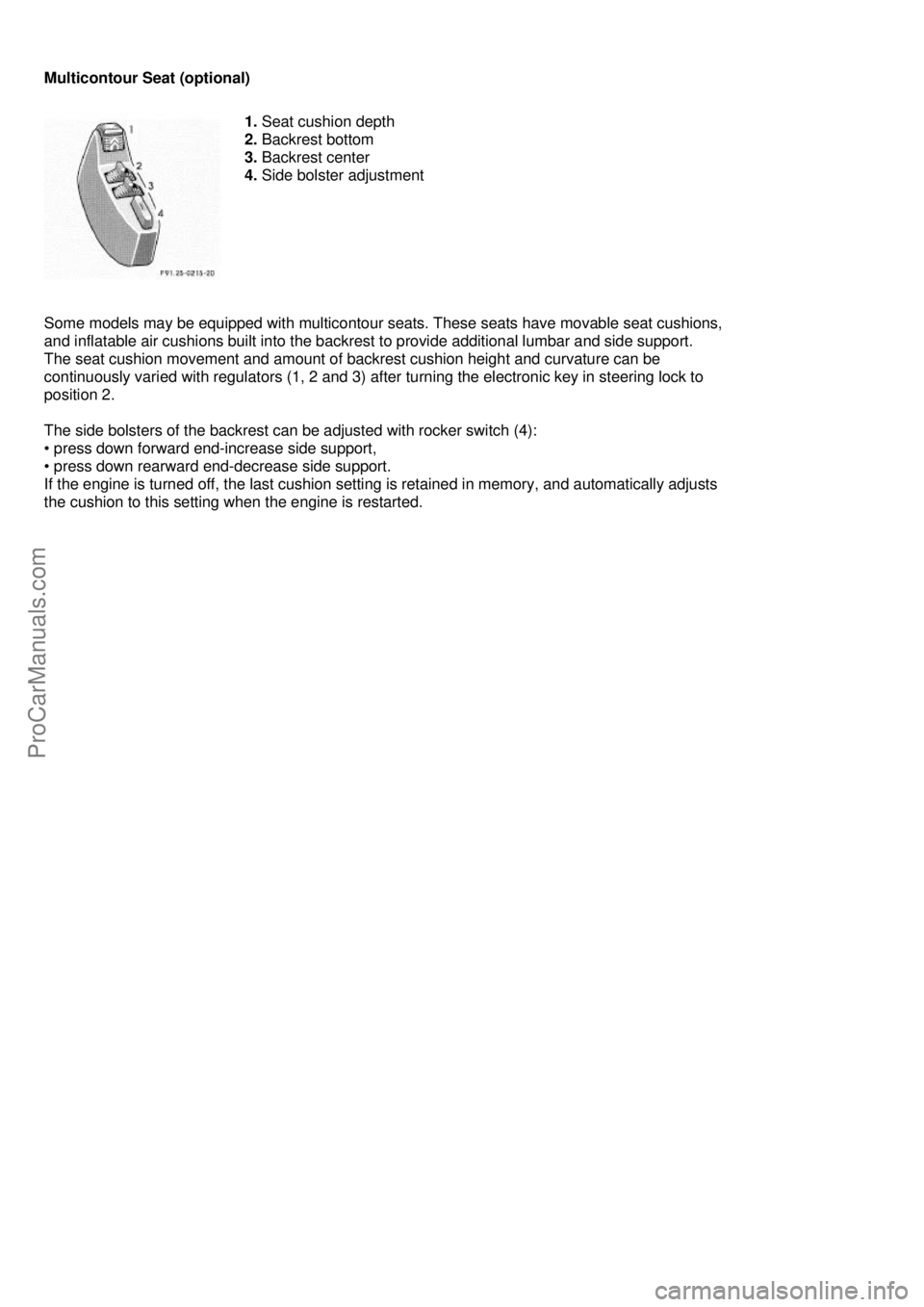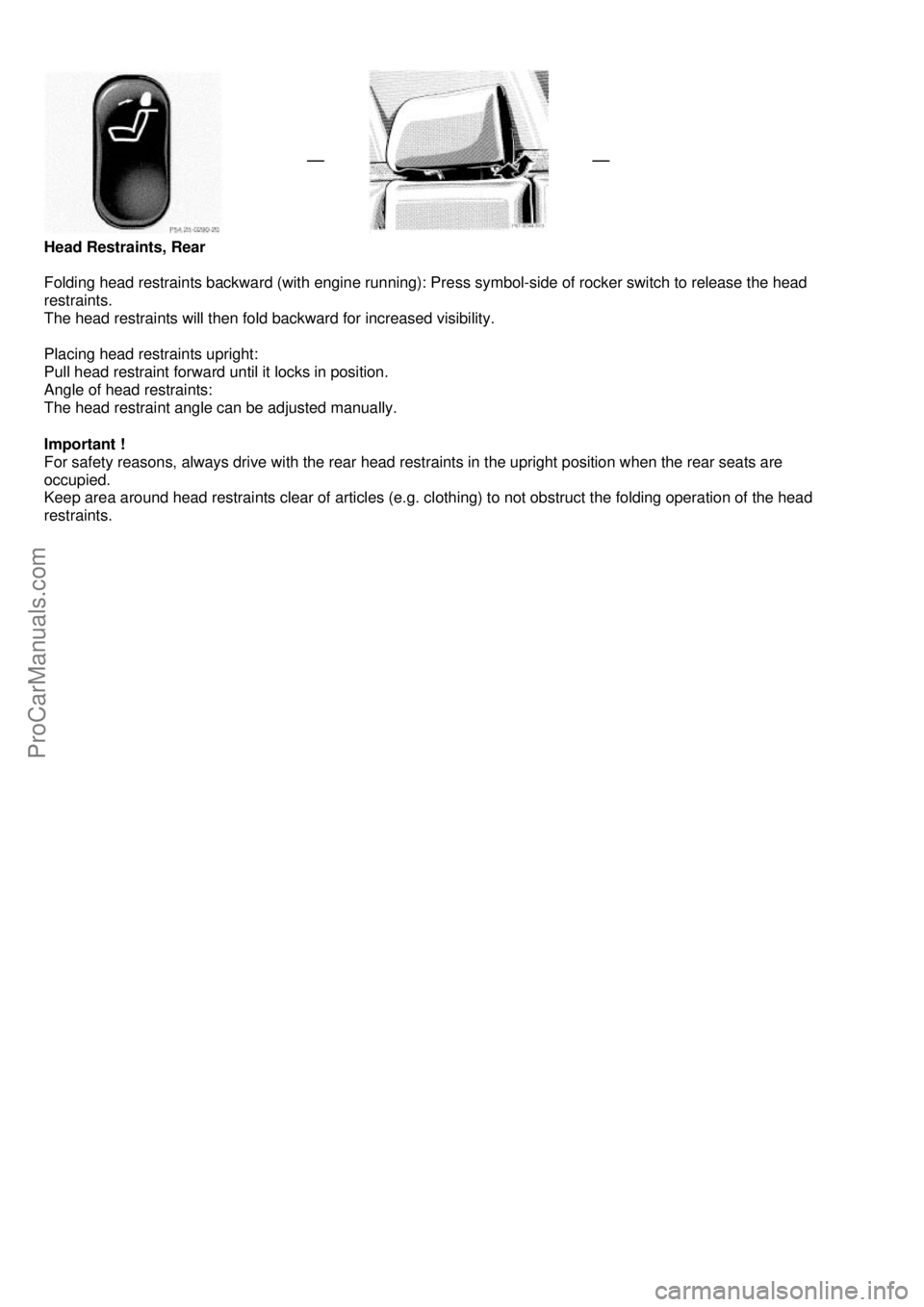seats MERCEDES-BENZ C-CLASS 1999 Owners Manual
[x] Cancel search | Manufacturer: MERCEDES-BENZ, Model Year: 1999, Model line: C-CLASS, Model: MERCEDES-BENZ C-CLASS 1999Pages: 122, PDF Size: 1.66 MB
Page 26 of 122

Seats, Front
Warning !
Do not adjust the driver's seat while driving. Adjusting the seat while driving could cause the driver to lose
control of the vehicle. Never ride in a moving vehicle with the seat back reclined. Sitting in an excessively
reclined position can be dangerous.
You could slide under the seat belt in a collision. If you slide under it, the belt would apply force at the
abdomen or neck. That could cause serious or even fatal injuries. The seat backrest and seat belt provide
the best restraint when the wearer is in an upright position and the belt is property positioned on the body.
Never place hands under seat or near any moving parts while a seat is being adjusted
A - Seat, fore/aft
B - Seat, up/down
C - Seat tilt
D - Backrest tilt
E - Head restraint
Adjust head restraint to support the back of the head approximately at ear level.
The head restraint angle can also be adjusted manually.
Note:
Your car is equipped with power head restraints , do not try to raise or lower them manually.
Power Seat
The slide switches are located in each front door. Turn elec tronic key in steering lock to position 1 or 2 (with a front
door open, the power seats can also be operated with the electronic key removed or in steering lock position 0).
Warning !
When leaving the vehicle always remove the electronic key from the steering lock. The power seats can also
be operated with the driver's or passenger door open. Do not leave children unattended in the vehicle or with
access to an unlocked vehicle. Unsupervised use of vehicle equipment may cause serious personal injury.
Caution !
Do not remove head restraints except when mounting seat co vers. For removal refer to Head Restraints, Front, see
Index. Whenever restraints have been removed be sure to reinstall them
before driving.
Important !
Prior to operating the vehicle, the driv er should adjust the seat height for proper vision as well as fore/aft placement
and seat back angle to insure adequate control, reach, operation, and comfort. The head restraint should also be
adjusted for proper height. See also airbag section for prope r seat positioning. Both the inside and outside rear view
mirrors should be adjusted for adequate rearward vision. Fasten seat belts. Infants and small children should be
seated in a properly secured restraint system that complies with U.S. Federal Motor Vehicle Safety Standard 213 and
Canadian Motor Vehicle Safety Standard 213.1. All seat, head restraint, and rear view mirror adjustments as well as
fastening of seat belts should be done before the vehicle is put into motion.
Warning !
Children 12 years old and under must never ride in the front seat, except in a Mercedes-Benz authorized
BabySmart™ compatible child seat, which operates with the BabySmart™ system installed in the vehicle to
deactivate the passenger side airbag when it is properly installed. Otherwise they will be struck by the airbag
when it inflates in a crash. If this happens, serious or fatal injury will result. The back seat is the safest place
for children. Infants and small children must ride in the back seats and be seated in an appropriate infant or
child restraint system, which is properly secured with the vehicle's seat belt, fully in accordance with the seat
manufacturer's instructions. A child's risk of serious or fatal injuries is significantly increased if the child
restraints are not properly secured in the vehicle and the child is not properly secured in the child restraint.
ProCarManuals.com
Page 28 of 122

Multicontour Seat (optional)
1. Seat cushion depth
2. Backrest bottom
3. Backrest center
4. Side bolster adjustment
Some models may be equipped with multicontour seats. These seats have movable seat cushions,
and inflatable air cushions built into the backrest to provide additional lumbar and side support.
The seat cushion movement and amount of backrest cushion height and curvature can be
continuously varied with regulators (1, 2 and 3) after turning the electronic key in steering lock to
position 2.
The side bolsters of the backrest can be adjusted with rocker switch (4):
• press down forward end-increase side support,
• press down rearward end-decrease side support.
If the engine is turned off, the last cushion setting is retained in memory, and automatically adjusts
the cushion to this setting when the engine is restarted.
ProCarManuals.com
Page 29 of 122

Heated Seats (optional)
The front seat heater switches are located in the center console. The front seat heaters
can be switched on with the electronic key in steering lock positions 1 or 2.
Press switch to turn on heater:
1. Normal heating mode. One indicator lamp in the switch lights up.
2. Rapid heating mode. Bo indicator lamps in the switch light up. After approximately
5 minutes in the rapid heating mode, the heater automatically witches to normal
operation and only one indicator lamp will stay on.
Turning off heater:
If one indicator lamp is on, press upper half of switch.
If both indicator lamps are on, press lower half of switch.
If left on, the heater automatically turns off after approximately 30 minutes of operation.
Note:
When in operation, the seat heater consumes a large amount of electrical power. It is not advisable to use the seat
heater longer than necessary. The seat heaters may automatically switch off if too many power consumers are
switched on at the same time, or if the battery charge is lo w. When this occurs, the indicator lamp in the switch will
blink (both indicator lamps blink during rapid seat heating) . The seat heaters will switch on again automatically as
soon as sufficient voltage is available. If the blinking of the indicator lamps is distracting to you, the seat heaters can
be switched off.
ProCarManuals.com
Page 31 of 122

Head Restraints, Rear
Folding head restraints backward (with engine running): Press symbol-side of rocker switch to release the head
restraints.
The head restraints will then fold backward for increased visibility.
Placing head restraints upright:
Pull head restraint forward until it locks in position.
Angle of head restraints:
The head restraint angle can be adjusted manually.
Important !
For safety reasons, always drive with the rear head rest raints in the upright position when the rear seats are
occupied.
Keep area around head restraints clear of articles (e.g. cl othing) to not obstruct the folding operation of the head
restraints.
ProCarManuals.com
Page 32 of 122

Seat Belts
Your vehicle is equipped with seat belts for all seats, emergency tensioning retractors for the front
seats, as well as front and side impact airbags and knee bolsters for driver and front passenger.
Important !
Laws in most states and all Canadian provinces require seat belt use. All states and provinces
require use of child restraints that comply with U.S. Federal Motor Vehicle Safety Standard 213 and
Canadian Motor Vehicle Safety Standard 213.1.
For your safety and that of your pass engers we strongly recommend their use.
Warning !
Children 12 years old and under must never ride in the front seat, except in a Mercedes-Benz
authorized BabySmart? compatible child seat, which operates with the BabySmart? system
installed in the vehicle to deactivate the passenger side front airbag when it is properly
installed. Otherwise they will be struck by the airbag when it inflates in a crash. If this
happens, serious or fatal injury will result. The back seat is the safest place for children.
Infants and small children must ride in back seats and be seated in an appropriate infant or
child restraint system, which is properly secured with the vehicle's seat belt, fully in
accordance with the seat manufacturer's instructions. A child's risk of serious or fatal
injuries is significantly increased if the child restraints are not properly secured in the vehicle
and the child is not properly secured in the child restraint.
Warning !
Never ride in a moving vehicle with the seat back reclined. Sitting in an excessively reclined
position can be dangerous. You could slide under the seat belt in a collision. If you slide
under it, the belt would apply force at the abdomen or neck. That could cause serious or even
fatal injuries. The seat back and seat belts provide the best restraint when the wearer is in an
upright position and belts are properly positioned on the body.
Seat Belt Warning System
With the electronic key in steering lock position 2, a warning sounds for a short time if the driver's
seat belt is not fastened.
Warning !
Failure to wear and properly fasten and position your seat belt greatly increases your risk of
injuries and their likely severity in an accident. You and your passengers should always wear
seat belts.
If you are ever in an accident, your injuries can be considerably more severe without your
seat belt properly buckled. Without your seat belt buckled, you are much more likely
to hit the interior of the vehicle or be ejected from it. You can be seriously injured or killed.
In the same crash, the possibility for injury or death is lessened with your seat belt
buckled.
ProCarManuals.com
Page 34 of 122

Warning !
USE SEAT BELTS PROPERLY.
• Each occu pant sh
ould wear their seat belt at a ll times, because seat belts help reduce the likelihood of
and potential severity of injuries in accidents, including rollovers. "SRS" (driver airbag, front passenger
airbag, front door side impact airbags), "ETR" (seat belt emergency tensioning retractors), and knee
bolsters are impacts which exceed preset deployment thresholds.
• Improperly positioned seat belts do not provide maximum protection and may
cause serious injuries in case of an accident.
• Never wear the shoulder belt under your arm, against your neck or off your shoulder. In a crash, your body
would move too far forward. That would increase the chance of head and neck injuries. The belt would
also apply too much force to the ribs or abdomen, which could severely injure infernal organs such as
your liver or spleen.
• Position the lap belt as low as possible on your hips and not across the abdomen.
If the belt is positioned across your abdomen, it could cause serious injuries in a crash.
• Each seat belt should never be used for more than one person at a time.
Do not fasten a seat belt around a person and objects.
• Belts should not be worn twisted. In a crash, you wouldn't have the full width of the belt to
manage impact forces. The twisted belt against your body could cause injuries.
• Pregnant women should also use a lap-shoulder belt. The lap belt portion should be positioned
as low as possible on the hips to avoid any possible pressure on the abdomen.
Warning !
USE CHILD RESTRA INTS PROPERLY.
Children 12 years old and under must never ride in the front seat, except in a Mercedes-Benz authorized
Baby Smart™ compatible child seat, which operates with the BabySmart™ system installed in the vehicle to
deactivate the passenger side front airbag when it is properly installed. Otherwise they will be struck by the
airbag when it inflates in a crash. If this happens, serious or fatal injury will result. The back seat is the safest
place for children. Infants and small children must ride in back seats and be seated in an appropriate infant
or child restraint system, which is properly secured with the vehicle's seat belt, fully in accordance with the
seat manufacturer's instructions.
A child's risk of serious or fatal injuries is significant ly increased if the child restraints are not properly
secured in the vehicle and the child is not properly secured in the child restraint. Children too big for child
restraint systems must ride in back seats using regular seat belts. Position shoulder belt across chest and
shoulder, not face or neck. A booster seat may be necessary to achieve proper belt positioning.
ProCarManuals.com
Page 35 of 122

BabySmart™ Airbag Deactivation System
Special child seats, designed for use with the Mercedes-Benz system and available at any
authorized Mercedes-Benz dealer are required for use with the BabySmart™ airbag deactivation
system. With the special child seat properly insta lled, the passenger front airbag will not deploy. The
indicator lamp located on the center console will be illuminated, except with electronic key
removed or in steering lock position 0. The system does not deactivate the door mounted side
impact airbag.
Warning !
The BabySmart™ Airbag Deactivation System will ONLY work with a special seat designed to
operate with it. It will not work with seats which are not BabySmart™ compatible. Never place
anything between seat cushion and child seat (e .g. pillow), since it reduces the effectiveness
of the deactivation system. Follow the manufacture r's instructions for installation of special
child seats. The passenger side front airbag will not deploy only if the
indicator lamp
remains illuminated. Please be sure to check the indicator every time you use the special
system child seat. Should the light go out while the restraint is installed, please check
installation. If the light remains out, do not use the BabySmart™ restraint to transport
children, or otherwise do not transport child restraints on the front passenger seat until the
system has been repaired.
Self-Test BabySmart™ Without Special Child Seat Installed
After turning electronic key in steering lock to position 1 or 2, the
indicator lamp located on
center console comes on for approx. 6 seconds.
If the lamp should not come on or is continuously li t, the system is not functioning. You must see an
authorized Mercedes-Benz dealer before using any child seat.
BabySmart is a trademark of Siemens Automotive Corp.
ProCarManuals.com
Page 37 of 122

Emergency Tensioning Retractor (ETR)
The seat belts for the front seats are equipped with emergency tensioning retractors. These tensioning retractors are
located in each belt's inertia reel and become operationally ready with the electronic key in steering lock position 1 or
2. The emergency tensioning retractors are designed to acti vate only when the seat belts are fastened during frontal
impacts exceeding the first threshold of the SRS and in rear impacts exceeding a preset security level. They remove
slack from the belts in such a way that the seat belts fit more snugly against the body restricting its forward movement
as much as possible.
In cases of other frontal impacts, angled impacts, roll-overs, certain side impacts, or other accidents without sufficient
frontal or rear impact forces, the emergency tensioning re tractors will not be activated. The driver and passengers will
then be protected by the fastened seat belts and inertia reel in the usual manner. For seat belt and emergency
tensioning retractor safety guidelines see Safety Guidelines in Index.
ProCarManuals.com
Page 40 of 122

Infant and Child Restraint Systems
We recommend that all infants and children be properly restra ined at all times while the vehicle is in motion. All lap-
shoulder belts except driver seat have special seat belt re tractors for secure fastening of child restraints. To fasten a
child restraint, use this seat belt: Follow child restraint in structions for routing. Then pull shoulder belt out completely
and let it retract. The belt is now locked. Push down on child restraint to take up any slack.
Important !
The use of infant or child restraints is required by law in all 50 states and all Canadian provinces. Infants and small
children should be seated in an appropriate infant or child restraint system properly secured by a lap-shoulder belt,
and that complies with U.S. Federal Motor Vehicle Safety Standard 213 and Canadian Motor Vehicle Safety Standard
213.1. A statement by the child rest raint manufacturer of compliance with this standard can be found on the
instruction label on the restraint and in the instruction manual provided with the restraint. When using any infant or
child restraint system, be sure to carefully read and follow all manufacturer's instructions for installation and use.
Please read and observe warning labels affixed to inside of vehicle.
Warning !
Children 12 years old and under must never ride in the front seat, except in a Mercedes-Benz authorized
BabySmart™ compatible child seat, which operates with the BabySmart™ system installed in the vehicle to
deactivate the passenger side front airbag when it is properly installed. Otherwise they will be struck by the
airbag when it inflates in a crash. If this happens, serious or fatal injury will result.
The back seat is the safest place for children, infants and small children must ride in back seats and be
seated in an infant or child restraint system, which is properly secured with the vehicle's seat belt, fully in
accordance with the seat manufacturer's instructions.
Infants and small children should never share a seat belt with another occupant. During an accident, they
could be crushed between the occupant and seat belt. Children too big for child restraint systems must ride
in back seats using regular seat belts. Position shoulder belt across chest and shoulder, not face or neck. A
booster seat is necessary to achieve proper belt positioning for children from 41 Ibs. to the point where a
lap/shoulder belt fits properly without one.
When the child restraint is not in use, remove it from the car or secure it with the seat belt to prevent the
child restraint from becoming a projectile in the event of an accident.
U.S.A. Models only:
Since 1986 all U.S. child restraints comply with U.S. regulations without the use of a tether strap. Canada Models
only: This vehicle is provided with tether anchorages for a top tether strap. Consult your authorized Mercedes-Benz
dealer for installation of these anchorages. In compliance with Canadian Motor Vehicle Safety Standard 210.1, child
restraint tether anchorage hardware is attached to the tool kit located in the trunk.
ProCarManuals.com
Page 44 of 122

Steering Lock
0 - The electronic key can be withdrawn in this position only. The steering is locked with the electronic key removed
from the steering lock. The electronic key an be removed only with the selector lever in position "P" and the foot
off the brake pedal. After removing the electronic key or with the electronic key in steering lock position 0, the
selector lever is locked in position "P".
1 - Steering is unlocked. (If necessary, move steering wheel s lightly to allow the electronic key to be turned clockwise
to position 1.) Most electrical consumers can be operated. For detailed information see respective subjects.
2 - Driving position.
3 - Starting position.
Refer to Index for Starting and turning off the engine.
Warning !
When leaving the vehicle always remove the electroni c key from the steering lock, and lock the vehicle.
Do not leave children unattended in the vehicle, or with access to an unlocked vehicle.
Unsupervised use of vehicle equipment may cause serious personal injury.
Important !
If the electronic key is left in the steering lock position 0 for an extended period of time, it can no longer be turned in
the lock. In this case, remove electron ic key from steering lock and reinsert.
Notes:
A warning sounds when the driver's door is opened with the el ectronic key in steering lock position 1 or 0. With the
engine at idle speed, the charging rate of the alternator (output) is limited. It is therefore recommended to turn off
unnecessary electrical consumers while driving in stop-and-go traffic. This precaution helps to avoid draining of the
battery. Unnecessary strain on the batte ry and charging system may be minimized by turning off the following power
consumers, for example: Heated seats, rear window defroster. In addition, the automatic climate air volume control
should be set to the lowest position. The steering lock can only be unlocked with the vehicle battery properly
connected.
Caution !
To prevent accelerated battery discharge and a possible dead battery, always remove the electronic key from the
steering lock. Do not leave the electronic key in steering lock position 0.
ProCarManuals.com